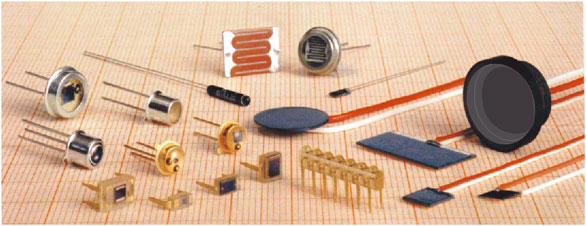

Optoelectronic components (or as often referred to photo-electronic components), are electronic components which produce light or react to it. Some components among them are LEDs (Light Emitting Diodes), photo transistors, photo diodes, photo resistors (or LDR – Light Dependant Resistors), different visual indicators, light emitters and detectors, optocouplers, etc. Many of those components can be recognized easily recognized because of the “window” on the component's case which is used to pass the light. Sometimes, instead of a window, there is a small lens, which directs light to some predestined location inside of the component. Some of the most important optoelectronic components are shown on photo 9.1.
 9.1 Photo-electronic components
9.1 Photo-electronic components
We already mentioned the most frequently used component of them – the LED. Basic role of a LED in circuits is a visual indicator of, for example, state of the device (on/off), but is not rare in other indicator appliances, voltage stabilizers, etc. There is an abundance of colors, shapes and sizes to choose from, but most frequent ones are red, green and yellow. Because of the different and more complicated manufacturing process, blue ones cost a bit more than other ones. There are square, housed, SMD, angled, ultra bright, multicolored and many other kinds, but they all have the same principles of use.
Another application of LEDs is a LED display. One display is on 9.2. It is, as shown, facilitated out of 8 diodes marked with an a,b,c,d,e,f,g and DP (DP being the Decimal Point). These devices come in two possible flavors – with a common cathode (as this display), or with a common anode. In both cases it is necessary to connect protection resistors to to all diodes (which is the same as when working with ordinary LEDs).
 Photo diodes are similar to other, ordinary, diodes internally. One main difference is in that that photo diode has an exposed surface to for light to fall onto. These diodes are acting as high value resistor while in dark. It's resistance lowers as light gains in intensity. In their behavior they are similar to photo resistors, apart from that as with all diodes polarity of the component must be appropriately positioned.
Photo diodes are similar to other, ordinary, diodes internally. One main difference is in that that photo diode has an exposed surface to for light to fall onto. These diodes are acting as high value resistor while in dark. It's resistance lowers as light gains in intensity. In their behavior they are similar to photo resistors, apart from that as with all diodes polarity of the component must be appropriately positioned.

Emitting diodes are special kind of photo-diodes. One of them is the LED, and some of them include infra-red or ultra-violet emitting for different wireless communication purposes. Most common area of application of IR-LEDs (Infra Red) are remote controllers for TVs and other devices. Photo diodes are usually housed in round metallic or square plastic cases with a glass window or a lens which focuses the incoming light. Photo-transistor's internal parts are similar to internals of a regular transistor. One main difference between them is the glass window which allows light to reach the crystal plate which holds all transistor's parts. With changes of light intensity, resistance between base and the collector varies, and this influences variations of the collector current. In this component light has the same role as voltage over base of the regular transistor. When intensity rises, current through the transistor rises as well, and other way round, if intensity fades, current fades. Photo electronic components are manufactured in an array of different case shapes and sizes. Several of them, together with their schematics symbols are displayed on 9.3. One special group of photo-electronic components are the optocouplers. These are special integrated circuits facilitated out of an IR photo diode, and some component which is sensitive to light (photo transistor, photo thyristor). Diode is called an emitter, and “receiving” end is called the detector. This means that the only connection between the emitter and detector is through a ray of light. This is an important property of optocouplers, since it allows two different parts of the circuit which operate on different supply voltages to connect to each other without actually conducting electricity, which means that one part could operate on 9V and other on 5V without fear of burning the sensitive lower voltage components.

There are several optocouplers and their cases on 9.4. Photo transistors on 9.4a are connected to other components in the same manner as ordinary transistors. Control of current which passes through it is done by light falling onto it. Voltage to the diode on 9.4a can be variable in time, but anode must always be positive compared to the cathode. In case this component is used in an alternating current circuit, diode emits light only during one half of the interval in which anode is positive comparing to cathode. It is possible to use circuit on 9.4b in case it is needed for diode to be lit during both periods. This circuit demonstrates two diodes in anti-parallel connection, so one of the two is lit during each half of the period. Picture 9.4c is an optocoupler using a thyristor. Thyristor is connected to other components in usual manner, and it starts conducting only upon receiving light impulse created by the diode. Transistor on 9.4d is controlled by regulating either the light intensity of the diode or voltage over pin 6. Same goes when using a triac on 9.4e, light intensity of the diode or voltage on pin6 trigger the circuit. Dual input NAND gate circuit is used as a detector on the 9.4f, one of those inputs controls the voltage on pin 7, and the other is controlling diode's light intensity. Logic zero on pin 6 remains only in case pin 7 has a logic one and diode is lit, any other case pin 6 has logic one.